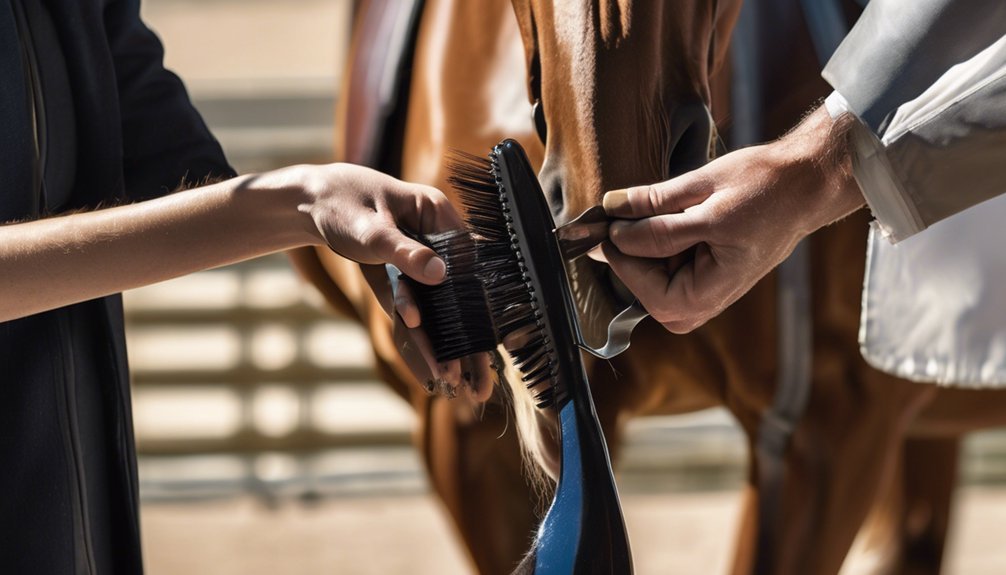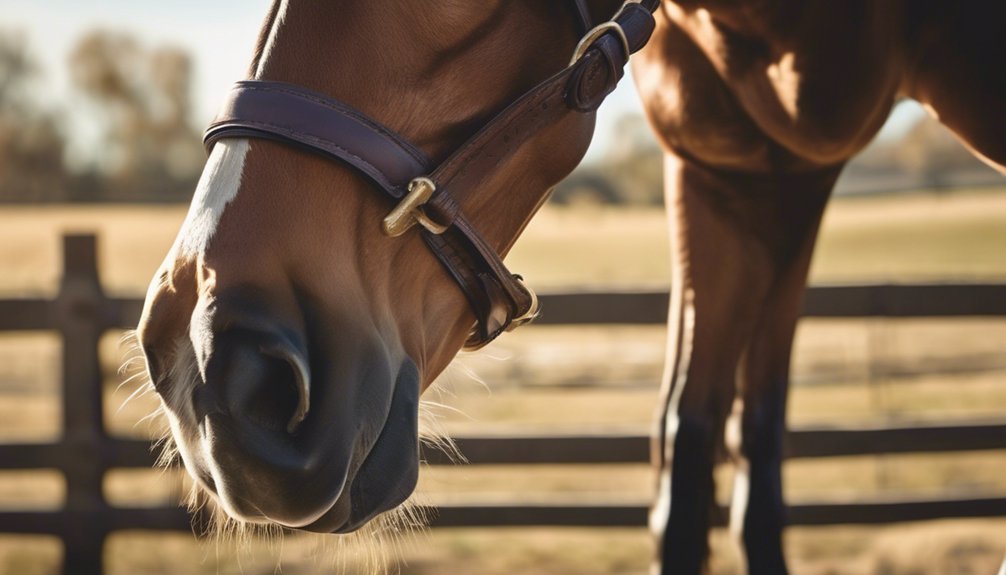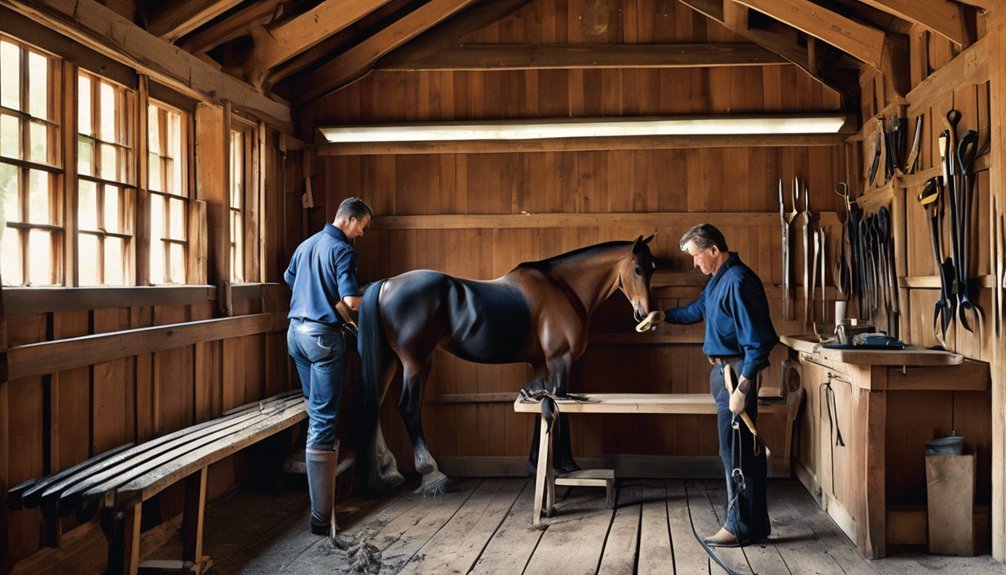
When it comes to grooming short-coated horses, you need to adopt a tailored approach that addresses their specific needs. Regular grooming not only keeps their coat looking sharp but also promotes skin health. You'll want to ensure you have the right tools and techniques at your disposal. Let's explore essential practices that can help maintain your horse's coat and skin, while also keeping an eye out for potential health issues.
Key Takeaways
- Groom short-coated horses 2-3 times a week, increasing to daily during warmer months to maintain coat health and cleanliness.
- Use a rubber curry comb first to loosen dirt, followed by a stiff brush to remove debris in the direction of hair growth.
- Finish grooming with a soft-bristled brush to enhance shine and distribute natural oils throughout the coat.
- Bathe every 4-6 weeks with a gentle, pH-balanced shampoo, using lukewarm water to maintain skin health without over-drying.
- Conduct regular health checks for irritations, lumps, or discharge during grooming to ensure overall well-being and prevent larger issues.
Understanding the Unique Needs of Short-Coated Horses

When grooming short-coated horses, it's essential to recognize their unique needs to maintain their health and appearance.
Short coat characteristics, such as sleekness and lower hair density, require you to adjust your grooming frequency to keep their skin healthy and free from dirt. Aim to groom them at least two to three times a week, focusing on removing debris and distributing natural oils.
Daily attention is beneficial, especially in warmer months when they sweat more. Pay special attention to sensitive areas, like the belly and legs, where skin irritation can occur.
Essential Grooming Tools for Short-Coated Horses
Grooming short-coated horses requires the right tools to ensure their skin stays healthy and their coat shines.
Start with quality grooming brushes, such as a rubber curry comb, which helps loosen dirt and debris while stimulating the skin. A soft-bristled finishing brush is essential for removing finer particles and adding that final polish to their sleek coat.
Don't forget shedding tools; a shedding blade or rake is invaluable during seasonal changes to manage loose hair effectively.
These tools not only enhance your horse's appearance but also promote healthy skin by encouraging blood circulation.
Investing in these essentials will make your grooming routine efficient and enjoyable, deepening the bond between you and your horse.
Brushing Techniques for Optimal Coat Health

Having the right tools is just the beginning; mastering brushing techniques is key to promoting optimal coat health.
Start with a curry comb to loosen dirt and debris, using firm, circular motions. Follow up with a stiff brush to remove the loosened particles, always brushing in the direction of hair growth.
For a finishing touch, use a soft brush to enhance coat shine and distribute natural oils. Aim for regular brushing—ideally daily—to maintain coat health and stimulate circulation.
This consistent brushing frequency not only keeps your horse clean but also contributes to a beautiful, glossy coat.
Bathing Best Practices for Short-Coated Horses
Although short-coated horses require less frequent bathing than their long-coated counterparts, it's essential to follow best practices to ensure their skin and coat remain healthy.
Here are some key tips:
- Shampoo Selection: Choose a gentle, pH-balanced shampoo specifically designed for horses. This helps maintain skin health without stripping natural oils.
- Bathing Frequency: Aim to bathe your horse every 4-6 weeks, unless they get particularly dirty. Over-bathing can lead to dryness.
- Water Temperature: Use lukewarm water for a comfortable experience. Cold water can be unpleasant, while hot water may irritate their skin.
Maintaining Skin Health and Hydration

To keep your horse's skin healthy and hydrated, it's crucial to focus on proper nutrition and routine care.
Start by ensuring your horse gets a balanced diet rich in essential fatty acids, which promote skin elasticity and hydration. Incorporate coat supplements that contain omega-3 and omega-6 fatty acids to enhance overall skin health from the inside out.
Regular grooming also plays a vital role; use soft brushes to stimulate the skin and distribute natural oils.
Additionally, consider applying skin moisturizers, especially during dry or cold weather, to prevent dryness and irritation.
Tackling Shedding Season Effectively
As the seasons change and temperatures rise, your horse will start shedding its winter coat, making it essential to tackle this process efficiently.
To help manage this shedding season, follow these steps:
- Use shedding brushes: These specialized tools effectively remove loose hair and dander, minimizing mess while keeping your horse comfortable.
- Establish a routine: Groom your horse regularly to help control the shedding process and reduce the risk of seasonal allergies.
- Monitor your horse's environment: Keep an eye on allergens in your horse's surroundings and consider using an air purifier in the stable to improve air quality.
Regular Health Checks During Grooming

While grooming your horse, it's crucial to incorporate regular health checks into your routine, ensuring your equine companion remains in optimal condition. This practice enhances health monitoring, allowing you to spot any issues early.
As you brush, take a moment to examine your horse's skin for irritations, lumps, or scratches. Check their hooves for stones or cracks and ensure they're clean and healthy.
Pay attention to their eyes and nostrils, looking for any discharge that could indicate health concerns. These simple checks are forms of preventative care that can save you from more significant problems down the line.
Tips for Managing Dirt and Mud
Managing dirt and mud effectively can make a significant difference in your grooming routine and your horse's overall comfort. Proper mud management ensures your horse stays clean and healthy.
Here are three essential tips for dirt removal:
- Pre-grooming preparation: Before you start grooming, use a rubber curry comb to loosen mud and dirt from your horse's coat. This makes removal easier and less stressful for both of you.
- Use the right tools: Invest in a good-quality grooming mitt or body brush designed for short coats. These tools can efficiently remove dirt while being gentle on your horse's skin.
- Establish a cleanup area: Create a designated spot for your horse to stand during grooming, minimizing the chances of re-soiling after you've cleaned them.
Creating a Consistent Grooming Routine

After effectively managing dirt and mud, establishing a consistent grooming routine is vital for maintaining your horse's health and appearance.
Create a grooming schedule that fits into your daily routine, ensuring you devote time to your horse's needs. Start by brushing your horse thoroughly to remove loose hair and dirt, following up with hoof care to check for stones or cracks.
Don't forget to inspect their skin for any irritations or injuries. Regular grooming not only keeps your horse looking its best but also strengthens your bond.
Aim to groom at the same times each day; consistency will help your horse feel secure and comfortable.
With dedication, your grooming routine will enhance your horse's overall well-being and happiness.
Frequently Asked Questions
Can I Use Human Shampoo on My Short-Coated Horse?
You shouldn't use human shampoo on your horse. The shampoo ingredients can harm their coat health, leading to dryness and irritation. Instead, opt for products specifically formulated for equine care to maintain their coat's vitality.
How Often Should I Groom My Horse With a Short Coat?
You should groom your horse regularly, ideally every few days, to maintain coat health and remove dirt or debris. Consistent grooming frequency enhances coat maintenance, strengthens your bond, and promotes your horse's overall well-being.
What Are Signs of Skin Issues in Short-Coated Horses?
Watch for signs of skin irritation, like redness or scratching. Fungal infections may present as flaky patches or unusual hair loss. Regular checks help you catch these issues early and keep your horse comfortable and healthy.
Is It Necessary to Use Conditioner on Short Coats?
You might wonder if conditioner's really necessary. While not essential, it enhances shine, aids in detangling, and nourishes the skin, making your grooming routine smoother and more effective, ultimately benefiting both you and your horse.
Are There Specific Supplements for Short-Coated Horse Health?
For short-coated horse health, consider supplements that address dietary needs, like omega fatty acids for skin and coat maintenance. A balanced diet enhances their overall well-being and keeps their coat vibrant and healthy.
Conclusion
By committing to a consistent grooming routine, you not only enhance your horse's appearance but also forge a deeper bond with your equine companion. Think of grooming as a daily ritual, a brushstroke on the canvas of your horse's health. With the right tools and techniques, you can keep their coat shining and their skin thriving. Remember, regular attention can prevent minor issues from becoming major problems, ensuring your horse remains vibrant and comfortable throughout the seasons.





